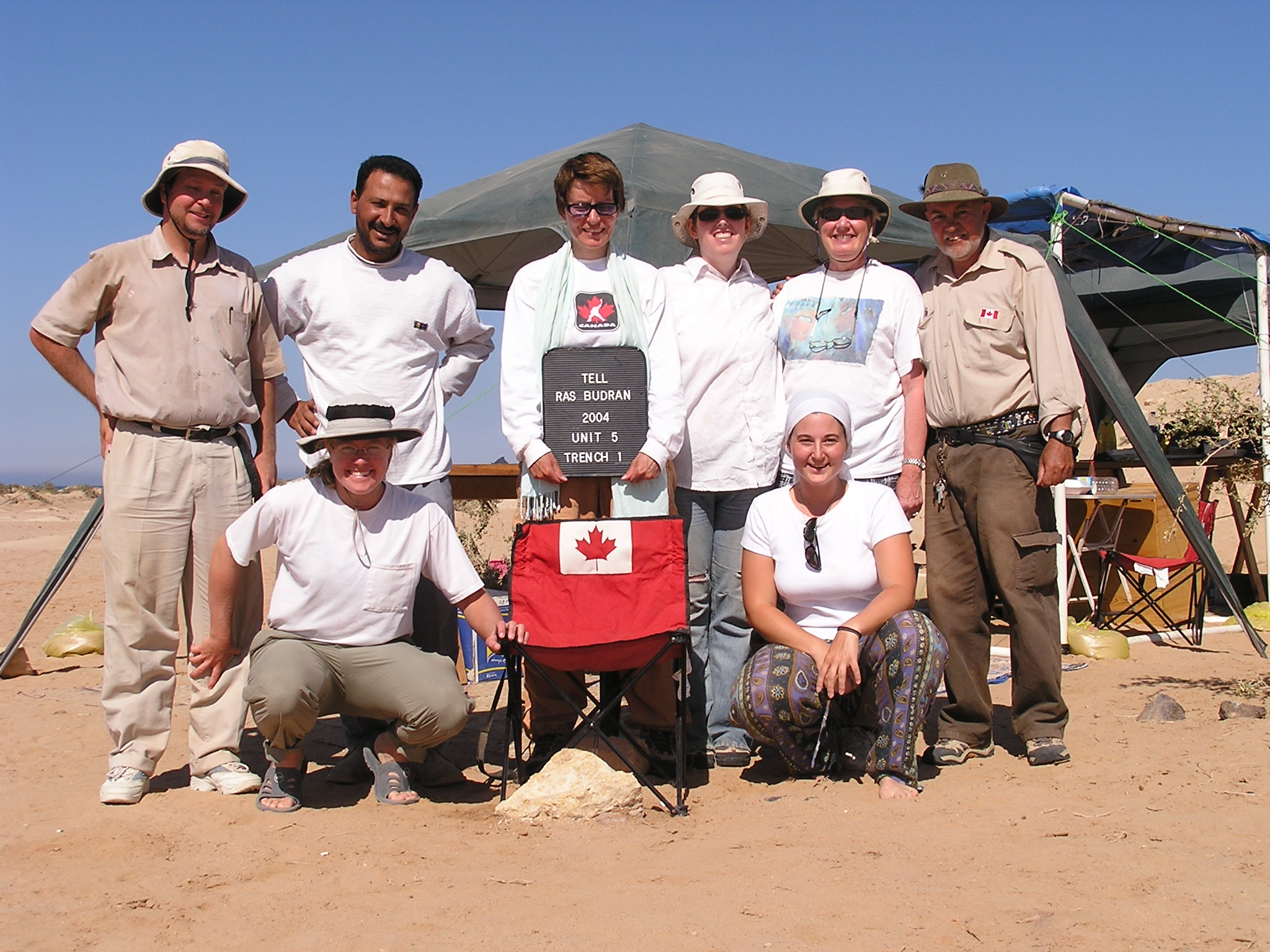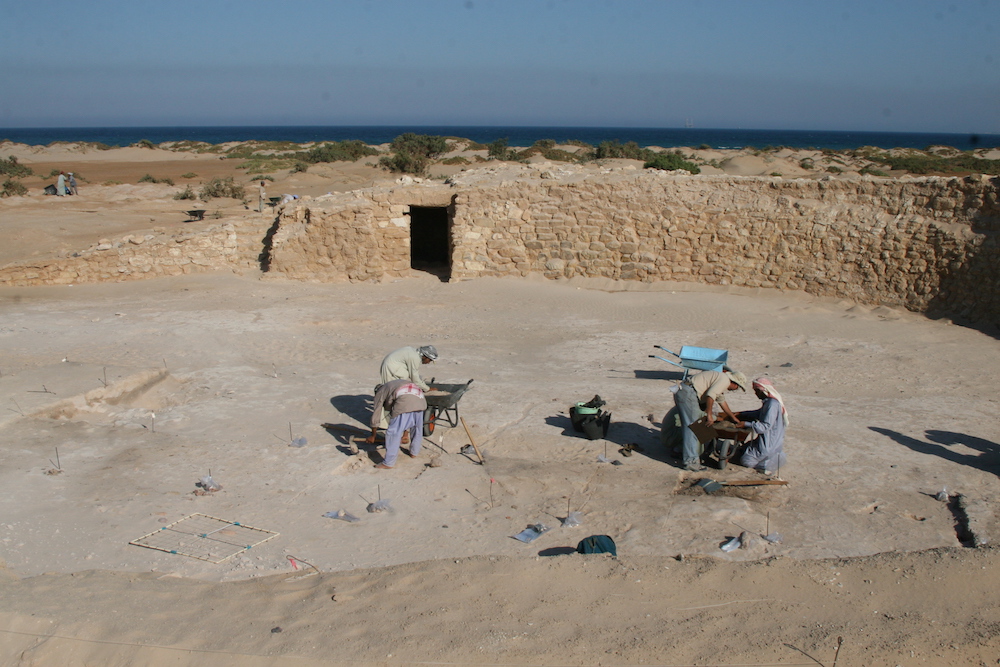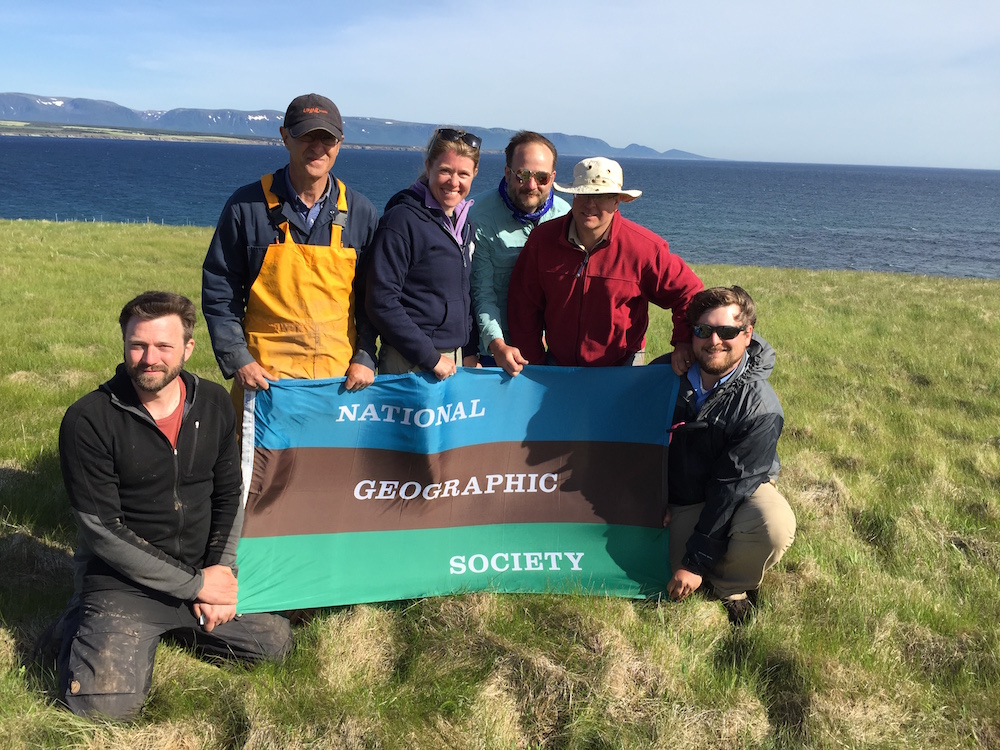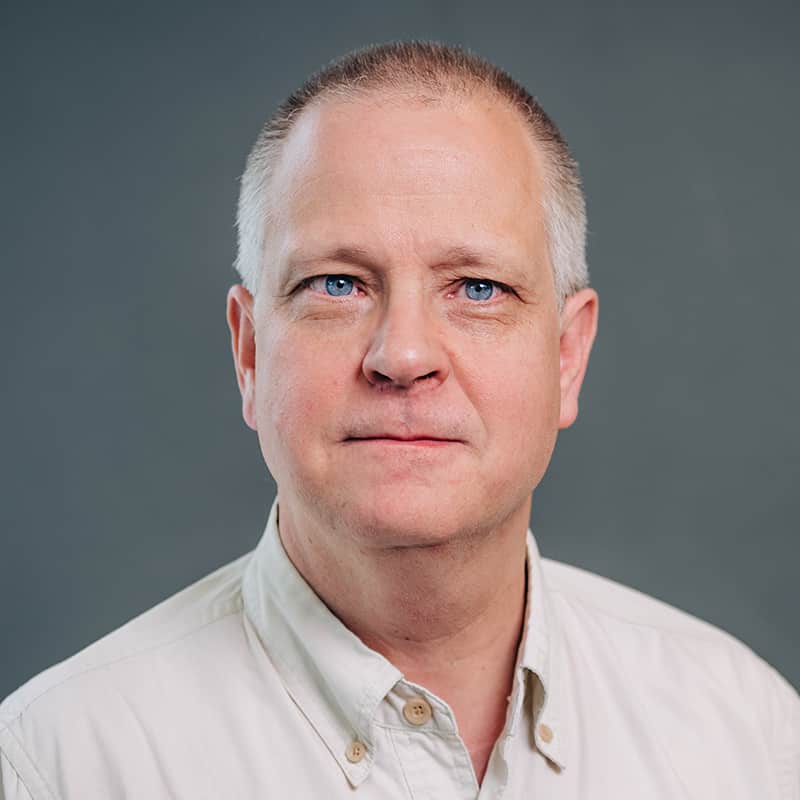Associate Professor
University Hall (UH) 3160
(205) 934-0490
Research and Teaching Interests: Archaeology and Ancient Egypt, Nubia, East Mediterranean, and Near East, including international relations (ca. 10,000 - 332 BCE)
Office Hours: By appointment
Education:
- BA, The University of Toronto
- MA, The University of Toronto
- PhD, The University of Toronto
 Ras Budran (South Sinai, Egypt) 2004 project members: G. Mumford, M. Rezk, D. Donnelly, Z. McQuinn, R. Hummel, and P. Carstens (left-right, back row), and S. Parcak and S. Christodoulou (left-right, front row) (Photo: Staff). Although I was born in Canada, I grew up in Nairobi, Kenya; Niagara Falls, Canada; and Pretoria, South Africa; during which I accompanied my parents on frequent trips to archaeological sites, museums, and public lectures in these and other countries. Upon returning to Canada I pursued a long-held childhood dream to become both an archaeologist and an Egyptologist; during my studies I expanded my interests to study Ancient Egypt and its neighbors (including Nubia, the Aegean, Anatolia, Syria-Palestine, and Mesopotamia) and began focusing upon international relations between these regions from Prehistory through the Pharaonic period (5,000-332 BCE). My other interests include architecture and the Vikings, two career options that I considered seriously, but have maintained mainly as side interests (I incorporate them into some courses).
Ras Budran (South Sinai, Egypt) 2004 project members: G. Mumford, M. Rezk, D. Donnelly, Z. McQuinn, R. Hummel, and P. Carstens (left-right, back row), and S. Parcak and S. Christodoulou (left-right, front row) (Photo: Staff). Although I was born in Canada, I grew up in Nairobi, Kenya; Niagara Falls, Canada; and Pretoria, South Africa; during which I accompanied my parents on frequent trips to archaeological sites, museums, and public lectures in these and other countries. Upon returning to Canada I pursued a long-held childhood dream to become both an archaeologist and an Egyptologist; during my studies I expanded my interests to study Ancient Egypt and its neighbors (including Nubia, the Aegean, Anatolia, Syria-Palestine, and Mesopotamia) and began focusing upon international relations between these regions from Prehistory through the Pharaonic period (5,000-332 BCE). My other interests include architecture and the Vikings, two career options that I considered seriously, but have maintained mainly as side interests (I incorporate them into some courses).  UAB/SCA 2008 expedition to Ras Budran (South Sinai, Egypt): Project director, G. Mumford, and Bedouin workers sieving materials from excavation grid across floor surface associated with late Old Kingdom fort in Sinai (Photo: P. Carstens).Like most students of archaeology, archaeological fieldwork especially attracted me, and I spent many summers either enrolled in fieldwork courses (surveying and excavating in the Chilcotin region of British Columbia, Canada; excavating at Tel Miqne-Ekron), or participating in archaeological projects in diverse parts of Egypt (surveying and excavating Western Desert prehistoric sites; drawing plans and sections in Merenptah’s Tomb in the Valley of the Kings; excavating housing, forts, and tombs in Karnak [Luxor], Mendes [East Delta], and at Tel Qedwa and Tel Borg [North Sinai]). More recently I have directed my own projects (Survey and Excavation Projects in Egypt), including a 1st millennium BCE port-town at Tell Tebilla (East Delta) and a late Old Kingdom fort at Ras Budran (South Sinai). I also currently co-direct, with Dr. Sarah Parcak, the 2014/15 through 2016 investigations at Point Rosee (Newfoundland, Canada), and co-direct, with Sarah Parcak and M. Youssef (the lead project directors), a joint Egyptian Ministry of Antiquities (MoA) and UAB expedition to el-Lisht in Egypt (beginning in December 2015).
UAB/SCA 2008 expedition to Ras Budran (South Sinai, Egypt): Project director, G. Mumford, and Bedouin workers sieving materials from excavation grid across floor surface associated with late Old Kingdom fort in Sinai (Photo: P. Carstens).Like most students of archaeology, archaeological fieldwork especially attracted me, and I spent many summers either enrolled in fieldwork courses (surveying and excavating in the Chilcotin region of British Columbia, Canada; excavating at Tel Miqne-Ekron), or participating in archaeological projects in diverse parts of Egypt (surveying and excavating Western Desert prehistoric sites; drawing plans and sections in Merenptah’s Tomb in the Valley of the Kings; excavating housing, forts, and tombs in Karnak [Luxor], Mendes [East Delta], and at Tel Qedwa and Tel Borg [North Sinai]). More recently I have directed my own projects (Survey and Excavation Projects in Egypt), including a 1st millennium BCE port-town at Tell Tebilla (East Delta) and a late Old Kingdom fort at Ras Budran (South Sinai). I also currently co-direct, with Dr. Sarah Parcak, the 2014/15 through 2016 investigations at Point Rosee (Newfoundland, Canada), and co-direct, with Sarah Parcak and M. Youssef (the lead project directors), a joint Egyptian Ministry of Antiquities (MoA) and UAB expedition to el-Lisht in Egypt (beginning in December 2015). UAB/Nat.Geo./BBC/Pbs-Nova 2015 expedition to Point Rosee (Newfoundland, Canada): D. Bolender, F. Schwarz, S. Parcak, D. Gathings, G. Mumford, and C. Childs (left-right; photo: Staff). Project directed by S. Parcak, G. Mumford and F. Schwarz in conjunction with Newfoundland PAO.I recommend that all my archaeology students obtain as broad an education as possible, and to pursue this sooner than later. See what regions, periods, and types of archaeology appeal most to you; encounter different peoples and cultures. Whether or not you choose to pursue a career in archaeology, you will make lifelong friends, colleagues, and gain a multitude of experiences and adventures that few other careers can furnish.
UAB/Nat.Geo./BBC/Pbs-Nova 2015 expedition to Point Rosee (Newfoundland, Canada): D. Bolender, F. Schwarz, S. Parcak, D. Gathings, G. Mumford, and C. Childs (left-right; photo: Staff). Project directed by S. Parcak, G. Mumford and F. Schwarz in conjunction with Newfoundland PAO.I recommend that all my archaeology students obtain as broad an education as possible, and to pursue this sooner than later. See what regions, periods, and types of archaeology appeal most to you; encounter different peoples and cultures. Whether or not you choose to pursue a career in archaeology, you will make lifelong friends, colleagues, and gain a multitude of experiences and adventures that few other careers can furnish.
At UAB I have striven to build and expand Sterne Library’s resources for Ancient Egypt and its neighbors, and to offer students both broader backgrounds to diverse past cultures across the globe and more specialized regional courses. Such gateway courses about diverse ancient peoples and places enable students to make informed choices early on regarding what areas they might wish to focus upon as they progress through undergraduate to graduate studies. For students who desire only to reconnoiter a few past societies of interest, such course offerings furnish a set of choices limited to relatively few North American universities and programs. See tentative, 5-year projection of my alternate year, elective course offerings (download as a Word document or as a PDF).
-
Recent Courses
- ANTH 000: The Vikings: Raiders, Traders, Farmers (Pending 2017+; this course is currently being offered as a directed reading)
- ANTH 106: Introduction to Archaeology (thematic & featuring 10 past cultures: Stonehenge; Iceman; Indus Valley; Rome; Celts; Zimbabwe culture; China; Maya; Inca) 106 ppt lectures
- ANTH 245: Mediterranean Area (Turkey/Anatolia, Greece/Aegean, and initially Europe, ca. 10,000-1,200 BCE) 245 ppt lectures
- ANTH 309: Egypt in the Age of Pyramids (Predynastic to Dynasty 17: ca. 10,000 - 1,550 BCE) 309 ppt lectures
- ANTH 310: Imperial and Post-Imperial Egypt (Dynasties 18-30, ca. 1,550 - 332 BCE) 310 ppt lectures
- ANTH 340: Archaeology & History of Bible Lands (Neolithic through Neo-Babylonian Empire in Syria-Palestine, ca. 10,000 - 586 BCE) 340 ppt lectures
- ANTH 416: War & Peace in Ancient Mesopotamia (Pending; Ancient Iraq, Syria, and adjacent areas: ca. 10,000-332 BCE)
- ANTH 446: Explorers, Mummies, Hieroglyphs (thematic approach to Ancient Egypt, including introductory hieroglyphs & selected explorers) 446 ppt lectures {/slider}
-
Research Interest
UAB/MoA 2015 expedition to el-Lisht (Egypt): G. Mumford planning mud brick entryway to a Middle Kingdom rock-cut tomb of Intef, "Great Overseer of the Army," at el-Lisht (project directed by S. Parcak, M. Youssef and G. Mumford; photo: S. Parcak).My main research area and interests consist of Ancient Egypt and Nubia, Ancient Egyptian interactions with its neighbors, and several East Mediterranean cultures during the Chalcolithic, Bronze Age, Iron Age, and later (e.g., Kushites; Bedu/Bedouin; Canaanites; Philistines; Judaeans; Phoenicians; Hittites; Assyrians; Babylonians; Persians; Minoans; Mycenaeans). I am also interested in the Neolithic and Hellenistic-Roman periods in this region, and have recently delved into a few other periods and geographic regions as well (e.g., the North Atlantic Norse/Vikings and Amerindians and Palaeoeskimo in eastern Canada).
See my academia.edu profile for further information on my research, including downloadable pdfs, links, periodic updates on my current CV, project website, published papers, pending papers, excavation reports (e.g., Tell Tebilla [northeast delta, Egypt]; Ras Budran [southwest Sinai, Egypt]), unpublished fieldwork reports, book reviews, doctoral dissertation, several student research guides/resources (Ancient Egypt; Near East; others), and selected current course offerings (i.e., full pdfs with power point lectures and other materials from several courses, including ANTH 106: Introduction to Archaeology; ANTH 245: Mediterranean Area [Aegean-Anatolia]; ANTH 309: Egypt in Age of Pyramids; ANTH 310: Imperial and Post-Imperial Egypt; ANTH 340: Bible Lands; and ANTH 446: Explorers/Mummies/Hieroglyphs).
I am currently completing a manuscript on Egypt’s relations with sub-Saharan Africa, the Red Sea, and Arabia, including the transmission of diverse commodities from these regions to the Mediterranean Area, from the Neolithic through 332 BCE. -
Select Publications
The following volume, book chapters, journal articles, and encyclopaedia articles/entries reflect my recent publications in the Department of Anthropology; a fuller listing is available in my CV, also posted on www.academia.edu.
Edited Books:- Gregory D. Mumford (ed.). The Sinai Peninsula, Special Issue of the Journal of Ancient Egyptian Interconnections, vol.7.1. Lexington: The University of Arizona Egyptian Expedition (2015).
Book Chapters:- Sarah Parcak and Gregory Mumford, “Remote sensing in the Valley of the Kings and its Hinterlands,” in The Oxford Handbook of the Valley of the Kings, R. H. Wilkinson and K. R. Weeks, eds. (Oxford: Oxford University Press, 2016).
- Gregory Mumford, “The Amman Airport structure: a re-assessment of its date-range, function and overall role in The Levant,” in Walls of the Prince: Egyptian Interactions with Southwest Asia in Antiquity. Essays in Honour of John S. Holladay, Jr., Culture and History of the Ancient Near East, Timothy P. Harrison, Edward B. Banning, and Stanley Klassen, eds. (Leiden: E. J. Brill, 2015).
- Gregory Mumford, “Egypt and the Levant,” in The Oxford Handbook of the Archaeology of the Levant c. 8000–332 BCE, M. Steiner and A. E. Killebrew, eds. (Oxford University Press, 2014).
Articles:- Sarah Parcak, David Gathings, Chase Childs, Gregory Mumford, and Eric Cline, "Satellite Evidence of Archaeological Site Looting in Egypt: 2002-2013,” Antiquity vol. 90 (issue 349, 2016): 185-205.
- Gregory Mumford, “The Sinai Peninsula and its environs: our changing perceptions of a pivotal land bridge between Egypt, the Levant, and Arabia,” The Journal of Ancient Egyptian Interconnections 7.1 (2015): 1-24.
- Gregory Mumford, “Explorations in el-Markha Plain, South Sinai: preliminary findings at Tell Markha (site 346) and elsewhere,” The Journal of Ancient Egyptian Interconnections 7.1 (2015): 91-115.
- Gregory Mumford and Rexine Hummel, “Preliminary findings at a late Old Kingdom fort in South Sinai, including the pottery, from the 2008 season,” The Journal of Ancient Egyptian Interconnections 7.1 (2015): 52-82.
Encyclopaedia Articles:- Gregory Mumford, “Forts, Pharaonic Egypt,” pp. 2724–30 in Encyclopaedia of Ancient History. R. Bagnell, et. al., eds. (Oxford: Wiley-Blackwell Publishing Ltd., 2012/13).
-
Student Mentoring & Opportunities
Studying prehistoric-historic cultures: For a summary of the various courses and potential means by which one can pursue studying Ancient Egypt, Nubia, the East Mediterranean, and Near East, at either the undergraduate level or in our new graduate program (i.e., Peace and Human Rights' MA) in the Department of Anthropology at UAB, and elsewhere at or outside UAB, please consult the attached (preliminary) document, plus similar and additional opportunities and resources for students outlined below:
Part of project library and resource aid for directed studies on Ancient Egypt, Nubia, Syria-Palestine, Mesopotamia, and other areas (Photo: G. Mumford).Undergraduate research/study (i.e., course credit): I encourage undergraduate (and graduate) students to consult with me (
This email address is being protected from spambots. You need JavaScript enabled to view it. ; HHB 320) and/or design independent study projects under my supervision (i.e., via our departmental directed study courses: Anth.492: Special Problems in Archaeology [3 or 6 credit hours];Anth.498: Honors Thesis Research [3 or 6 credit hours]), particularly within areas in which I specialize or can best assist. For instance, I often supervise directed reading/research topics involving most aspects of Ancient Egypt and Nubia (Predynastic period through 332 BCE), Syria-Palestine (Chalcolithic to Iron Age: ca. 5000 – 586 BCE), and to some extent Mesopotamia (ca. 4000 – 332 BCE) and Anatolia and the Aegean/Greece (ca. 10,000 – 1200 BCE).
Such potential directed study projects will need to focus more narrowly upon an aspect of and shorter time span within these various areas, which encompass archaeology, history, art, architecture, society, economy, religion, literature, and material culture, plus relations between past cultures. Other potential studies might incorporate unpublished project materials from my excavations in Egypt, namely a late Old Kingdom fort (ca. 2300 – 2200 BCE) and a Late Period port-town (ca. 664 – 343 BCE), either one of which could furnish a directed “artifact/object study,” using project notes, drawings, and photographs, that might translate into a joint future publication with me. The most recent project at el-Lisht (Egypt) may also offer some potential student research projects, especially regarding art history, architecture, and the Middle Kingdom in general.
2015 view of reconstructed Norse/Viking housing at L'Anse aux Meadows, Newfoundland, Canada; original site dating ca. 1000 AD (Photo: G. Mumford).
Other undergraduate research/study (across multiple departments): I have sufficient background to oversee some Norse/Viking research related topics too (see pending course: The Vikings: Raiders, Traders, Farmers), but this lies outside my prime expertise. For further interest in the Vikings/Norse and Medieval period, see Dr. Jill Clements, Dept. of English, UAB, and other UAB courses in the English Department’s Literature program: e.g., EH 329. Literature of the Vikings; EH 469. Medieval Culture: Literature and Society; EH 471. Beowulf in Context. A broader background is also furnished via History Department courses: e.g.,HY 101. Western Civilization I; HY 219/319. Late Antiquity and Early Middle Ages; HY 230/330. Middle East 550 BCE to 1453 CE; HY 460. Ancient and Medieval Britain). See also Dr. Noa Turel, Dept. of Art & Art History, and a few pertinent courses offered by this department: e.g., ARH 203. Ancient and Medieval Art; ARH 419. Arts of Death in the Middle Ages. In addition, UAB offers some Museum Studies courses: See our department’s course in Museum Studies (ANTH 467/667. Museum Studies), the Art and Art History Department also offers some Museum Studies courses (e.g., ARH 485/585. Special Topics: Museum Studies; ARH 492/592. Museum/Gallery Internship).Selected books in Mumford & Sterne Library’s collections pertaining to graduate topics in ancient Peace and Human Rights’ topics. Master of Arts degree/program in Peace and Human Rights: As part of our newly introduced Anthropology MA degree in Peace and Human Rights (at UAB), in addition to meeting the requirements of the graduate program (see also Dr. Cormier),graduate students are welcome to take a range of elective courses from me (usually offered in alternate years), including Anth.516 (War and Peace in Ancient Mesopotamia), Anth.640 (Archaeology & History of Bible Lands), and Anth.646 (Explorers, Mummies & Hieroglyphs). These three courses are cross-listed at the undergraduate level, with graduate students attending the lectures/discussion, completing any documentary response assignments, but focusing mainly on a major research paper (e.g., usually around 25 pages). I periodically offer a graduate-dedicated seminar, Anth.649 (Egyptian History & Archaeology), which covers Egypt’s imperial period (Dynasties 18-20: 1550-1150+ BCE).
Student volunteer working with project ceramicist (R. Hummel) at Ras Budran, South Sinai, during 2004 season (Photo: P. Carstens).In addition, graduate students are encouraged to design a research topic, either as a directed reading course (Anth.692: Special problems in Archaeology, 1-6 hours), or a supervised MA thesis (Anth.699: Thesis research, 1-6 hours) (see above for my various areas of expertise and possibilities regarding topic selection and supervision; see also my recent courses for sample syllabi and links to ppt lectures). Regarding the Peace and Human Rights’ MA degree, essay and research topics under my supervision can easily concentrate upon such subjects as ancient warfare, diplomacy, treaties, cross-cultural relations, social institutions and rights, law, gender roles and status, and many other pertinent aspects in pharaonic Egypt and the Bronze through Iron Age East Mediterranean and Near East. Please consult our catalogue of graduate degree courses and elective courses, and emerging new program, to see what specific courses are being offered during the current academic year and semester.
Egypt fieldwork opportunities (limited): In addition, Dr. Parcak and I often select one or two undergraduate and/or graduate students demonstrating such things as (1) significant interest in the region of fieldwork (e.g., enrollment in key background courses: Egypt; archaeology), (2) diligence (i.e., excellent in-class attendance and participation), (3) high scholastic achievement (i.e., good grades and quality assignments), (4) pertinent skills (e.g., fieldwork training/experience; possibly remote sensing background), and (5) good “team work” (i.e., for working well with others in difficult field conditions) to participate in archaeological fieldwork (Anth 329/629. Egypt: Arch Field School. 6 hours) and/or project internships (e.g., Anth 436/636. Community Internship. 3-6 hours; see Anthropology internships). Our project teams and periodic/few internships have very limited space, thus the availability and number of such positions fluctuate and may not be open yearly, but we also welcome volunteers to aid in diverse project work such as scanning archival slides and try to provide work study positions whenever possible (see project/SEPE website; see Work Study program & eligibility). Mumford participation in UBC Anthropology Dept. 1985 archaeology field school: gridding out a lithic scatter near Eagle Lake, Chilcotin region, BC, Canada (Photo: G. Mumford).Other fieldwork opportunities (open): Diverse fieldwork training is often provided via Anthropology courses at UAB (e.g., Anth 226. Archaeological fieldwork school; Anth 411/611. Advanced field archaeology; Anth 442/642. Historical archaeology), or through other fieldwork training programs elsewhere (i.e., arrange transfer credit to UAB), volunteer opportunities (i.e., bolster experience; resume/CV), and participation involving different cultures and time periods at a regional, national, or international level (e.g., see AAA; AIA; AFW; APD; ATP Egypt; Earthwatch; Project Alabama). Our Anthropology faculty can also guide students in selecting the optimum programs, projects and desired geographic and cultural focus. In the spirit of archaeological fieldwork and anthropological experience/study amongst other cultures, students are also encouraged to look into the many opportunities offered via UAB’s Education Abroad and International Studies programs.
Mumford participation in UBC Anthropology Dept. 1985 archaeology field school: gridding out a lithic scatter near Eagle Lake, Chilcotin region, BC, Canada (Photo: G. Mumford).Other fieldwork opportunities (open): Diverse fieldwork training is often provided via Anthropology courses at UAB (e.g., Anth 226. Archaeological fieldwork school; Anth 411/611. Advanced field archaeology; Anth 442/642. Historical archaeology), or through other fieldwork training programs elsewhere (i.e., arrange transfer credit to UAB), volunteer opportunities (i.e., bolster experience; resume/CV), and participation involving different cultures and time periods at a regional, national, or international level (e.g., see AAA; AIA; AFW; APD; ATP Egypt; Earthwatch; Project Alabama). Our Anthropology faculty can also guide students in selecting the optimum programs, projects and desired geographic and cultural focus. In the spirit of archaeological fieldwork and anthropological experience/study amongst other cultures, students are also encouraged to look into the many opportunities offered via UAB’s Education Abroad and International Studies programs. Mumford building (with others) an experimental Athapaskan winter lodge during UBC Anthropology Dept. 1985 archaeology field school on Potato Mountain, Chilcotin region, BC, Canada (Photo: Philip).Benefits of mentoring and related projects: Regardless of one’s specific area of scholastic interest, all experience and training is useful for future careers in archaeology, related fields of study, and other disciplines as well. We encourage our students to inquire about and pursue volunteer positions at museums (e.g., AMHS; Birmingham Museum of Art; Civil Rights Institute; Southern Museum of Flight; Vulcan Park & Museum), other Alabama museums ;(e.g., Alabama Iron & Steel Museum [Tannehill]; Berman Museum of World History [Anniston]; Moundville Archaeological Park), work with local, regional, or other archaeological projects (e.g., Red Mountain; Moundville; Project Archaeology [Alabama]; UAB projects [see Stephen Merritt, Koobi Fora]; etc.), and get more involved in the UAB Anthropology Club, student presentations (at/via UAB), joining professional archaeological societies (e.g., Alabama Archaeological Society [AAS]; American Institute of Archaeology [AIA]; Society for American Archaeology [SAA]; American Research Center in Egypt [ARCE]; American Schools of Oriental Research [ASOR]), attending professional archaeological and anthropological conferences (e.g., SAA, AIA), publishing undergraduate/graduate papers, and obtaining other indispensable tools that will enable one to create both a firm and competitive foundation for one’s scholastic training, obtaining practical experience, entry to optimum graduate programs, receipt of scholarships, and overall preparation for future career(s). See the attached (preliminary) document for some tips and guidance in building and formatting one's resume/CV during one's undergraduate through graduate studies.
Mumford building (with others) an experimental Athapaskan winter lodge during UBC Anthropology Dept. 1985 archaeology field school on Potato Mountain, Chilcotin region, BC, Canada (Photo: Philip).Benefits of mentoring and related projects: Regardless of one’s specific area of scholastic interest, all experience and training is useful for future careers in archaeology, related fields of study, and other disciplines as well. We encourage our students to inquire about and pursue volunteer positions at museums (e.g., AMHS; Birmingham Museum of Art; Civil Rights Institute; Southern Museum of Flight; Vulcan Park & Museum), other Alabama museums ;(e.g., Alabama Iron & Steel Museum [Tannehill]; Berman Museum of World History [Anniston]; Moundville Archaeological Park), work with local, regional, or other archaeological projects (e.g., Red Mountain; Moundville; Project Archaeology [Alabama]; UAB projects [see Stephen Merritt, Koobi Fora]; etc.), and get more involved in the UAB Anthropology Club, student presentations (at/via UAB), joining professional archaeological societies (e.g., Alabama Archaeological Society [AAS]; American Institute of Archaeology [AIA]; Society for American Archaeology [SAA]; American Research Center in Egypt [ARCE]; American Schools of Oriental Research [ASOR]), attending professional archaeological and anthropological conferences (e.g., SAA, AIA), publishing undergraduate/graduate papers, and obtaining other indispensable tools that will enable one to create both a firm and competitive foundation for one’s scholastic training, obtaining practical experience, entry to optimum graduate programs, receipt of scholarships, and overall preparation for future career(s). See the attached (preliminary) document for some tips and guidance in building and formatting one's resume/CV during one's undergraduate through graduate studies.
UAB Anthropology student participating in 2016 field season at Point Rosee, processing flotation samples (Photo: K. Christodoulou). Various resources for student guidance: Our department website contains a discussion about and web links to various avenues open to Anthropology Majors and Minors seeking: general advising on different study programs at UAB, anthropological faculty’s advice on our programs, our Honors program, peer advice, funds and scholarships, internships, work study, archaeological fieldwork (“digs”), professional career development, post-program careers, and other things. See also the CAS advisor for Anthropology undergraduates: Tisha Morrisey (HHB 402).
Other important student resources: A wide range of other guidance, resources, assistance, and diverse services are available to UAB students concerning studies, academic services, withdrawals, appeals, housing, financial aid, health, well-being, safety, various problems and issues, and many other things (see attached document). -
Academic Distinctions & Professional Memberships
- The American Research Center in Egypt (ARCE)
- The American Schools of Oriental Research (ASOR)
- The Egypt Exploration Society (EES)
- The Society for the Study of Egyptian Antiquities (SSEA)
- Archaeological Institute of America (AIA)
- Society for American Archaeology (SAA)
